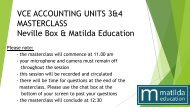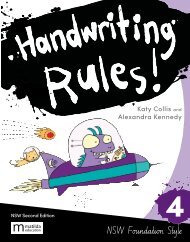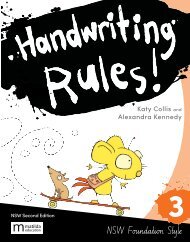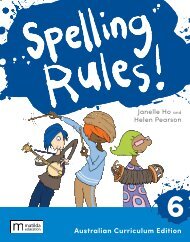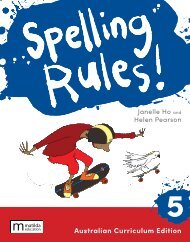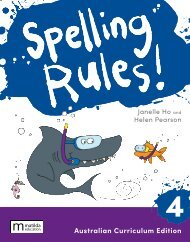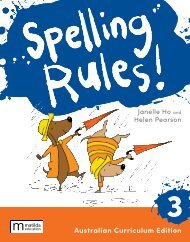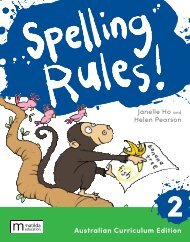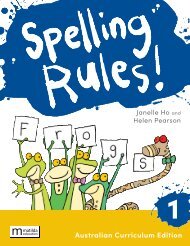Good Science Victorian Curriculum Year 7
Digital sample of Matilda's newest publication, Good Science Victorian Curriculum Year, authored by Emma Craven and Aaron Elias. For more information visit www.matildaeducation.com.au or email Katrina Tucker, katrinatucker@matildaed.com.au
Digital sample of Matilda's newest publication, Good Science Victorian Curriculum Year, authored by Emma Craven and Aaron Elias. For more information visit www.matildaeducation.com.au or email Katrina Tucker, katrinatucker@matildaed.com.au
Create successful ePaper yourself
Turn your PDF publications into a flip-book with our unique Google optimized e-Paper software.
SCIENCE SKILLS<br />
1.4<br />
QUESTIONING,<br />
PREDICTING AND<br />
PLANNING<br />
KEY TERMS<br />
controlled variables<br />
all the things that need to stay<br />
the same during an investigation<br />
dependent variable<br />
the thing that will be measured<br />
and is altered by the<br />
independent variable<br />
experiment<br />
an investigation carried out<br />
under controlled conditions,<br />
to test a hypothesis<br />
fair test<br />
an investigation in which only<br />
one factor is changed and all<br />
other variables are kept the<br />
same<br />
fieldwork<br />
an investigation conducted<br />
in the natural environment,<br />
not a laboratory<br />
hypothesis<br />
a scientific statement that<br />
can be tested<br />
independent variable<br />
the thing that is purposely<br />
changed during an investigation<br />
reliable<br />
provides consistent results<br />
when repeated<br />
research<br />
to gather data and information<br />
in an organised way to inform<br />
a hypothesis or investigation<br />
valid<br />
measures what is intended<br />
to be measured<br />
1<br />
2<br />
<strong>Science</strong> is all about investigating – asking questions, looking<br />
at data and drawing conclusions about how things work.<br />
A scientist is like a detective, but instead of investigating<br />
a crime, they’re investigating the world. To be useful,<br />
a good scientific test needs to follow certain principles.<br />
<strong>Good</strong> science needs to be valid and reliable<br />
When scientists design investigations, they ask themselves ‘is this<br />
good science?’<br />
To figure out if something is good science, you need to check that it’s<br />
both valid and reliable. If a test is reliable, you can do the test over and<br />
over again and get very similar results. If a test is valid, it measures what<br />
it is supposed to measure.<br />
Imagine you design a catapult that launches marshmallows and<br />
decide to test it against a friend’s design. Just as your friend is firing the<br />
catapult, a massive gust of wind blows their marshmallow further than<br />
yours – that’s not fair, right? It’s not a valid outcome because the wind<br />
caused the increased distance, not the catapult. The test didn’t measure<br />
what you wanted it to measure (the power of the catapult); it measured<br />
the power of the catapult and the power of the wind. It’s not reliable<br />
because, if you did the test again, the wind might be weaker, stronger<br />
or not there at all.<br />
Why does good science need to be valid and reliable?<br />
A fair test needs to be controlled<br />
Fair tests are essential for good science. A fair test is one in which only<br />
one variable is changed and all other variables are kept the same.<br />
Variables are the things that can be controlled, changed or measured<br />
during an investigation or experiment. There are three main types of<br />
variable: independent, dependent and controlled variables.<br />
The dependent variable is what you are measuring in an investigation,<br />
and is what is altered by the independent variable. Examples include<br />
time in seconds or mass in grams. The controlled variables are all the<br />
things you will keep the same. Examples of controlled variables are<br />
temperature, mass, equipment, location and volume.<br />
Figure 1.8<br />
Experiments are<br />
carried out in order<br />
to test a hypothesis.<br />
10 GOOD SCIENCE VICTORIAN CURRICULUM 7










